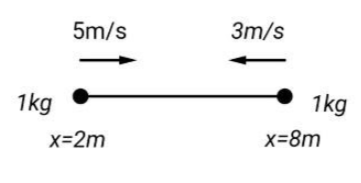
The figure shows the positions and velocities of two particles. If the particles move under the mutual attraction of each other, then the position of the center of mass at t=1s is:

A). x=5m
B). x= 6m
C). x= 3m
D). x= 2m

Answer
575.1k+ views
Hint: Find the initial position of centre of mass using the centre of mass formula. Then calculate velocity of centre of mass. From velocity, find the value of displacement and add with the initial position. Thus, you can calculate the position of centre of mass at time t= 1s.
Formula used:
X= $\dfrac {{m}_{1}{x}_{1}+{m}_{2}{x}_{2}}{{m}_{1}+{m}_{2}}$
v= $\dfrac {{m}_{1}{v}_{1}+{m}_{2}{v}_{2}}{{m}_{1}+{m}_{2}}$
Complete step-by-step solution:
Given: mass of both the particles ${m}_{1}$ and ${ m}_{2}$= 1kg
${x}_{1}$= 2m
${x}_{2}$= 8m
Using the centre of mass formula, initial position of centre of mass is given by,
X= $\dfrac {{m}_{1}{x}_{1}+{m}_{2}{x}_{2}}{{m}_{1}+{m}_{2}}$
Substituting values in above equation we get,
X=$\dfrac {1×2 + 1×8}{1+1}$
$\Rightarrow X= \dfrac {10}{2}$
$\Rightarrow X=5m$
Now, using the centre of mass formula, velocity of center of mass is given by,
v= $\dfrac {{m}_{1}{v}_{1}+{m}_{2}{v}_{2}}{{m}_{1}+{m}_{2}}$
Substituting values in above equation we get,
v=$\dfrac {1×5 - 1×3}{1+1}$
$\Rightarrow v= \dfrac {2}{2}$
$\Rightarrow v= 1{m}/{s}$
But $velocity=\dfrac {displacement}{time}$
$\Rightarrow displacement= velocity × time$
Substituting value of time and velocity we get,
$ displacement= 1 × 1$
$\therefore displacement= 1m$
Position of center of mass at t =1s is $5+1= 6m$
Thus, the position of center of mass at t =1s is 6m.
Hence, the correct answer is option B i.e. x=6m.
Note: Here, ${v}_{2}$ is taken negative as the particles are moving in opposite directions. So, take care of the negative sign and don’t consider the velocity of the second particle to be positive.
In the case of rigid bodies, the centre of mass does not depend on the state of the body whether it is in rest or accelerated.
Formula used:
X= $\dfrac {{m}_{1}{x}_{1}+{m}_{2}{x}_{2}}{{m}_{1}+{m}_{2}}$
v= $\dfrac {{m}_{1}{v}_{1}+{m}_{2}{v}_{2}}{{m}_{1}+{m}_{2}}$
Complete step-by-step solution:
Given: mass of both the particles ${m}_{1}$ and ${ m}_{2}$= 1kg
${x}_{1}$= 2m
${x}_{2}$= 8m
Using the centre of mass formula, initial position of centre of mass is given by,
X= $\dfrac {{m}_{1}{x}_{1}+{m}_{2}{x}_{2}}{{m}_{1}+{m}_{2}}$
Substituting values in above equation we get,
X=$\dfrac {1×2 + 1×8}{1+1}$
$\Rightarrow X= \dfrac {10}{2}$
$\Rightarrow X=5m$
Now, using the centre of mass formula, velocity of center of mass is given by,
v= $\dfrac {{m}_{1}{v}_{1}+{m}_{2}{v}_{2}}{{m}_{1}+{m}_{2}}$
Substituting values in above equation we get,
v=$\dfrac {1×5 - 1×3}{1+1}$
$\Rightarrow v= \dfrac {2}{2}$
$\Rightarrow v= 1{m}/{s}$
But $velocity=\dfrac {displacement}{time}$
$\Rightarrow displacement= velocity × time$
Substituting value of time and velocity we get,
$ displacement= 1 × 1$
$\therefore displacement= 1m$
Position of center of mass at t =1s is $5+1= 6m$
Thus, the position of center of mass at t =1s is 6m.
Hence, the correct answer is option B i.e. x=6m.
Note: Here, ${v}_{2}$ is taken negative as the particles are moving in opposite directions. So, take care of the negative sign and don’t consider the velocity of the second particle to be positive.
In the case of rigid bodies, the centre of mass does not depend on the state of the body whether it is in rest or accelerated.
Recently Updated Pages
Master Class 11 Business Studies: Engaging Questions & Answers for Success

Master Class 11 Computer Science: Engaging Questions & Answers for Success

Master Class 11 Maths: Engaging Questions & Answers for Success

Master Class 11 Chemistry: Engaging Questions & Answers for Success

Master Class 11 Economics: Engaging Questions & Answers for Success

Master Class 11 Accountancy: Engaging Questions & Answers for Success

Trending doubts
What is meant by exothermic and endothermic reactions class 11 chemistry CBSE

10 examples of friction in our daily life

One Metric ton is equal to kg A 10000 B 1000 C 100 class 11 physics CBSE

1 Quintal is equal to a 110 kg b 10 kg c 100kg d 1000 class 11 physics CBSE

Difference Between Prokaryotic Cells and Eukaryotic Cells

What are Quantum numbers Explain the quantum number class 11 chemistry CBSE




